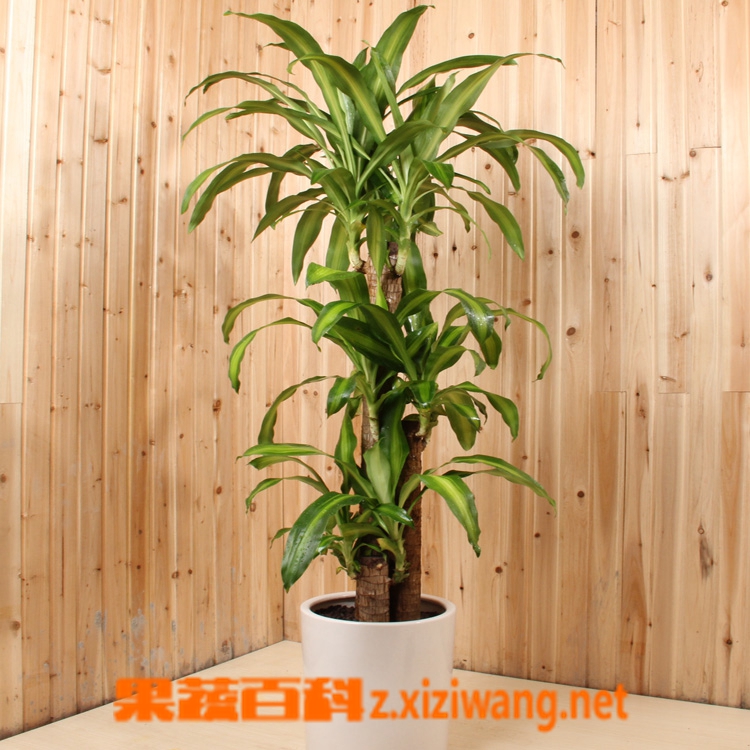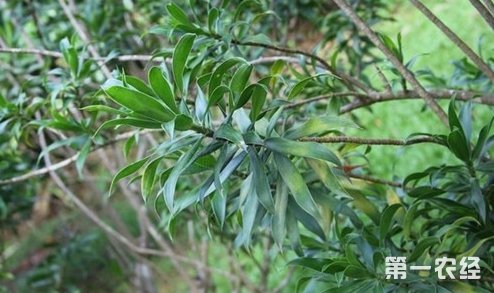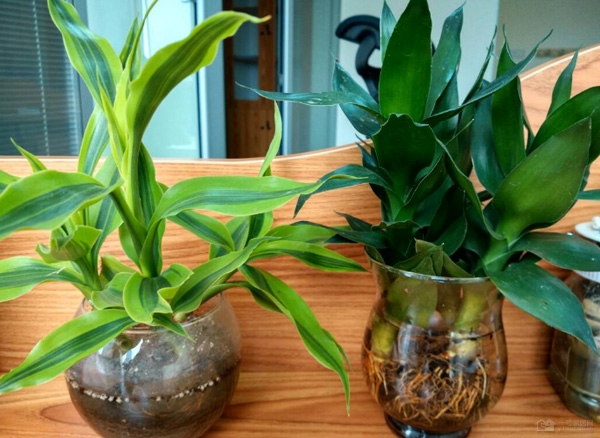Culture and maintenance methods of Brazilian wood in winter
The cultivation and conservation method of Brazilian wood in winter, Brazilian wood, also known as Brazilian iron tree or fragrant thousand-year-old wood, is an evergreen indoor foliage plant, common varieties are Phnom Penh Brazilian wood, gold heart Brazilian wood and so on.
There are two situations of Brazilian wood overwintering indoors. One is that the temperature is suitable, the light is sufficient, and the Brazilian wood is in a normal growth state. At this time, due to exuberant growth, large water consumption, prone to water shortage, we should pay attention to timely watering, generally 2-3 days once a day is appropriate. Second, the temperature is low, the light is weak, and the Brazilian wood is in a state of slow growth, at this time, the water consumption is less, and it is easy to appear waterlogging, so it should be watered less appropriately, on the one hand, it can improve the cold resistance of Brazilian wood, on the other hand, it can also enhance the soil permeability. ensure the normal respiration of the roots.
Improper maintenance in winter often leads to the following problems:
The leaves are wilting and sagging, the leaves are not glossy and energetic, and there is no improvement after watering. Most of these problems are caused by root rot caused by too much or too little watering, and the rotten roots should be removed. If the bottom pile is rotten, it can be sawed off, soak it in 2 ‰ potassium permanganate water for 10 minutes and 30 minutes, and bury it in the matrix soil with good drainage, such as sand or ash. If the center of the leaf bud blackens and gradually rotten, it is due to the low temperature, which is mostly caused by frost injury. If the skin of the stake is not rotten, it can also be moved to a high temperature to send out new buds and remove the old buds to renew. Leaf edge coke edge or dry tip, some are caused by air drying, can often be improved by foliar spray; some are caused by low temperature and slow dormancy. The most suitable temperature should be 20-25 ℃ (growth slows down below 13 ℃, frostbite occurs below 5 ℃). The yellow lines of the leaves fade because the indoor light is too dark, which can be changed by proper exposure to some sunlight. the above is the introduction of the cultivation and maintenance methods of Brazilian wood in winter.
Culture and conservation methods of Brazilian wood
Brazilian wood itself comes from Africa and is now more common in the south of China and Southeast Asian countries. Brazilian wood has strong vitality and is suitable to be placed in the hall or study as a large potted plant to increase the layout style of the whole room. Next, let's learn about the culture and conservation methods of Ximu.

Culture and conservation methods of Brazilian wood
1. Soil: Brazilian wood is suitable for loose, well-drained, humus-rich sandy loam soil and avoid alkaline soil. Pot soil should use rotten leaf soil or peat soil, add about 1 to 4 river sand or perlite and a small amount of mature organic fertilizer. The soil is loose, well drained and rich in organic matter, which is beneficial to its growth.
2. Sunlight: Brazilian wood has a wide range of adaptation to light, but it is not resistant to strong light, especially from May to October, which will lead to yellowing of leaves or scorching of leaf tips. Although it is shady, but too shady will also make the leaf color dim, especially the variegated leaf varieties, the markings on the leaf surface are easy to disappear, reducing the ornamental value.
3. Temperature: the suitable temperature for Brazilian wood growth is 20 ℃ to 28 ℃, the dormancy temperature is 13 ℃, and the overwintering temperature is 5 ℃. If the temperature is too low, chloasma will appear at the tip and edge of the leaf, and in serious cases, the shoots or the whole plant will be damaged by freezing. Therefore, it is necessary to move to the greenhouse for maintenance in winter in the north. If it is placed indoors, it should be placed in a place with light, and it is better to keep it above 6 ℃ to 8 ℃ at room temperature.
4. Watering: the long-term maintenance of northern Brazilian wood is in spring, summer and autumn, watering every 2 to 3 days in sunny days, and spraying water to the leaves once or twice a day. It is appropriate to control the amount of watering after the end of autumn and keep the basin soil slightly wet. Watering should be controlled in winter, and the basin soil should be kept semi-dry and semi-wet, such as excessive watering will rot roots and scorch leaves.
5. Fertilization: Brazilian wood needs to consume some of its own nutrients in the process of growth, at this time, if it is not fertilized in time, it will cause insufficient stamina and gradual degradation. During the growing period, organic fertilizer was first applied at the base or edge, and then liquid fertilizer or compound fertilizer was applied once or twice every 15 to 20 days to ensure the luxuriant growth of branches and leaves. Fertilization should be thin fertilizer, do not thick fertilizer, fertilizer application period is from May to October every year. Stop fertilizing in winter and move indoors for the winter. For variegated varieties, attention should be paid to reducing the proportion of nitrogen fertilizer, so as not to cause excessive growth of leaves, and lead to dull or even disappear speckles.
6. Insect pests: the common pests of Brazilian wood are leaf spot and anthracnose, which can be sprayed with 1000 times of methyl topiramate wettable powder. Insect pests are harmful to shell insects and aphids and can be sprayed with 1000 times omethoate EC. The third point of the breeding method of Brazilian wood is to pay attention to soil and fertilizer. Brazilian wood is suitable for growing in the loose sandy loam soil of the Feiwo River. In addition, the Brazilian wood has to change the basin and soil once a year to keep the nutrients in the soil adequate. In general, organic fertilizer is applied at the base or edge of the growing period, and then liquid fertilizer is applied every 15 to 20 days to ensure the luxuriant growth of branches and leaves. Introduction to the method of culturing Brazilian wood
How to raise Brazilian wood correctly?
Brazilian wood culture method 1, soil: Brazilian wood is suitable for loose, well-drained, humus-rich sandy loam soil, avoid alkaline soil. Pot soil should use rotten leaf soil or peat soil, add about 1 to 4 river sand or perlite and a small amount of mature organic fertilizer. The soil is loose, well drained and rich in organic matter, which is beneficial to its growth.
Brazilian wood culture method 2, sunlight: Brazilian wood adapts to a wide range of light, but is not resistant to strong light, especially from May to October, the strong light will lead to leaf yellowing or leaf tip scorching, should pay attention to sunshade, give brighter scattered light. Although it is shady, but too shady will also make the leaf color dim, especially the variegated leaf varieties, the markings on the leaf surface are easy to disappear, reducing the ornamental value.
Culture method of Brazilian wood 3. Temperature: the suitable temperature for the growth of Brazilian wood is 20 ℃ to 28 ℃, the dormant temperature is 13 ℃, and the overwintering temperature is 5 ℃. If the temperature is too low, chloasma will appear at the tip and edge of the leaf, and in serious cases, the shoots or the whole plant will be damaged by freezing. Therefore, it is necessary to move to the greenhouse for maintenance in winter in the north. If it is placed indoors, it should be placed in a place with light, and it is better to keep it above 6 ℃ to 8 ℃ at room temperature.
The cultivation method of Brazilian wood 4. Watering: the growth of northern Brazilian wood is maintained for a long time in spring, summer and autumn, watering every 2 to 3 days in sunny days, and spraying water to the leaves once or twice a day. It is appropriate to control the amount of watering after the end of autumn and keep the basin soil slightly wet. Watering should be controlled in winter, and the basin soil should be kept semi-dry and semi-wet, such as excessive watering will rot roots and scorch leaves.
Brazilian wood culture method 5, fertilization: Brazilian wood growth process needs to consume some of its own nutrients, if you do not apply fertilizer in time, it will cause lack of stamina and gradual degradation. During the growing period, organic fertilizer was first applied at the base or edge, and then liquid fertilizer or compound fertilizer was applied once or twice every 15 to 20 days to ensure the luxuriant growth of branches and leaves. Fertilization should be thin fertilizer, do not thick fertilizer, fertilizer application period is from May to October every year. Stop fertilizing in winter and move indoors for the winter. For variegated varieties, attention should be paid to reducing the proportion of nitrogen fertilizer, so as not to cause excessive growth of leaves, and lead to dull or even disappear speckles.
Breeding methods of Brazilian wood 6, pest control: common pests of Brazilian wood are leaf spot and anthracnose, which can be sprayed with 1000 times of methyl topiramate wettable powder. Insect pests are harmful to shell insects and aphids and can be sprayed with 1000 times omethoate EC.
- Prev

Propagation methods of Dragon Blood Tree
According to the propagation method of dragon blood tree, after it was introduced into China, the asexual propagation was mainly carried out by means of high pressure and cuttings in other areas, except that seeds were increased in a few tropical areas. (1) striping propagation. The stem of the dragon blood tree grows mostly erect and has few branches. After several years of plant growth, the basal leaves fall off.
- Next

How to raise rich bamboo in Phnom Penh
How to raise rich bamboo in Phnom Penh? at present, there are more and more businessmen supplying rich bamboo in the flower trade market. There are two kinds of rich bamboo varieties, one is all-green leaves, the other is golden leaf edge, also known as Phnom Penh rich bamboo, the latter is more expensive. This kind of rich bamboo in Phnom Penh is cut into pieces.
Related
- Fuxing push coffee new agricultural production and marketing class: lack of small-scale processing plants
- Jujube rice field leisure farm deep ploughing Yilan for five years to create a space for organic food and play
- Nongyu Farm-A trial of organic papaya for brave women with advanced technology
- Four points for attention in the prevention and control of diseases and insect pests of edible fungi
- How to add nutrient solution to Edible Fungi
- Is there any good way to control edible fungus mites?
- Open Inoculation Technology of Edible Fungi
- Is there any clever way to use fertilizer for edible fungus in winter?
- What agents are used to kill the pathogens of edible fungi in the mushroom shed?
- Rapid drying of Edible Fungi

